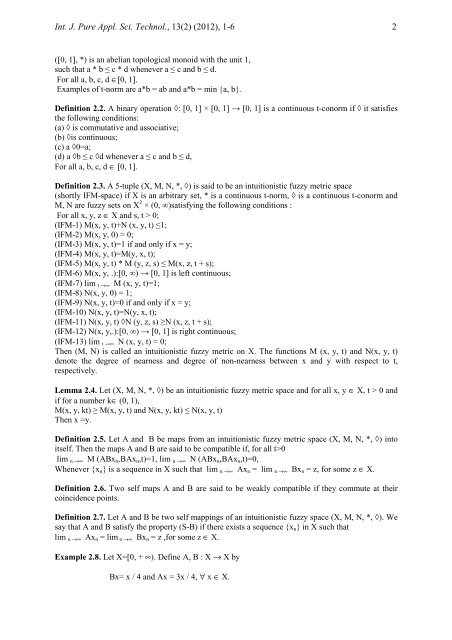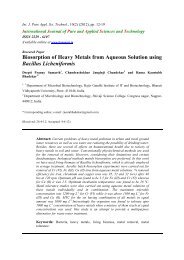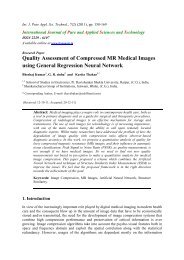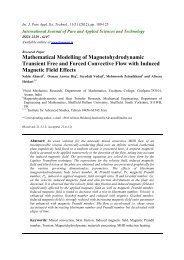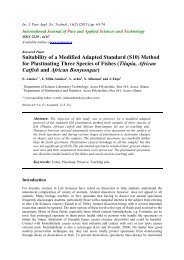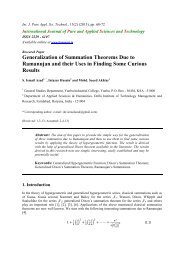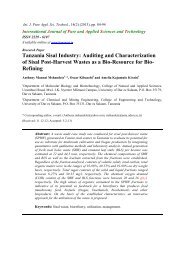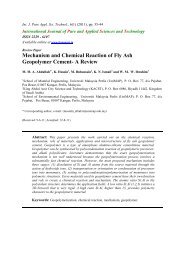Common Fixed Point Theorem in Intuitionistic Fuzzy Metric Space ...
Common Fixed Point Theorem in Intuitionistic Fuzzy Metric Space ...
Common Fixed Point Theorem in Intuitionistic Fuzzy Metric Space ...
- No tags were found...
You also want an ePaper? Increase the reach of your titles
YUMPU automatically turns print PDFs into web optimized ePapers that Google loves.
Int. J. Pure Appl. Sci. Technol., 13(2) (2012), 1-6 2<br />
([0, 1], *) is an abelian topological monoid with the unit 1,<br />
such that a * b ≤ c * d whenever a ≤ c and b ≤ d.<br />
For all a, b, c, d ∈[0, 1].<br />
Examples of t-norm are a*b = ab and a*b = m<strong>in</strong> {a, b}.<br />
Def<strong>in</strong>ition 2.2. A b<strong>in</strong>ary operation ◊: [0, 1] × [0, 1] → [0, 1] is a cont<strong>in</strong>uous t-conorm if ◊ it satisfies<br />
the follow<strong>in</strong>g conditions:<br />
(a) ◊ is commutative and associative;<br />
(b) ◊is cont<strong>in</strong>uous;<br />
(c) a ◊0=a;<br />
(d) a ◊b ≤ c ◊d whenever a ≤ c and b ≤ d,<br />
For all a, b, c, d ∈ [0, 1].<br />
Def<strong>in</strong>ition 2.3. A 5-tuple (X, M, N, *, ◊) is said to be an <strong>in</strong>tuitionistic fuzzy metric space<br />
(shortly IFM-space) if X is an arbitrary set, * is a cont<strong>in</strong>uous t-norm, ◊ is a cont<strong>in</strong>uous t-conorm and<br />
M, N are fuzzy sets on X 2 × (0, ∞)satisfy<strong>in</strong>g the follow<strong>in</strong>g conditions :<br />
For all x, y, z ∈ X and s, t > 0;<br />
(IFM-1) M(x, y, t)+N (x, y, t) ≤1;<br />
(IFM-2) M(x, y, 0) = 0;<br />
(IFM-3) M(x, y, t)=1 if and only if x = y;<br />
(IFM-4) M(x, y, t)=M(y, x, t);<br />
(IFM-5) M(x, y, t) * M (y, z, s) ≤ M(x, z, t + s);<br />
(IFM-6) M(x, y, .):[0, ∞) → [0, 1] is left cont<strong>in</strong>uous;<br />
(IFM-7) lim t →∞ M (x, y, t)=1;<br />
(IFM-8) N(x, y, 0) = 1;<br />
(IFM-9) N(x, y, t)=0 if and only if x = y;<br />
(IFM-10) N(x, y, t)=N(y, x, t);<br />
(IFM-11) N(x, y, t) ◊N (y, z, s) ≥N (x, z, t + s);<br />
(IFM-12) N(x, y,.):[0, ∞) → [0, 1] is right cont<strong>in</strong>uous;<br />
(IFM-13) lim t →∞ N (x, y, t) = 0;<br />
Then (M, N) is called an <strong>in</strong>tuitionistic fuzzy metric on X. The functions M (x, y, t) and N(x, y, t)<br />
denote the degree of nearness and degree of non-nearness between x and y with respect to t,<br />
respectively.<br />
Lemma 2.4. Let (X, M, N, *, ◊) be an <strong>in</strong>tuitionistic fuzzy metric space and for all x, y ∈ X, t > 0 and<br />
if for a number k∈ (0, 1),<br />
M(x, y, kt) ≥ M(x, y, t) and N(x, y, kt) ≤ N(x, y, t)<br />
Then x =y.<br />
Def<strong>in</strong>ition 2.5. Let A and B be maps from an <strong>in</strong>tuitionistic fuzzy metric space (X, M, N, *, ◊) <strong>in</strong>to<br />
itself. Then the maps A and B are said to be compatible if, for all t>0<br />
lim n →∞ M (ABx n ,BAx n ,t)=1, lim n →∞ N (ABx n ,BAx n ,t)=0,<br />
Whenever {x n } is a sequence <strong>in</strong> X such that lim n →∞ Ax n = lim n →∞ Bx n = z, for some z ∈ X.<br />
Def<strong>in</strong>ition 2.6. Two self maps A and B are said to be weakly compatible if they commute at their<br />
co<strong>in</strong>cidence po<strong>in</strong>ts.<br />
Def<strong>in</strong>ition 2.7. Let A and B be two self mapp<strong>in</strong>gs of an <strong>in</strong>tuitionistic fuzzy space (X, M, N, *, ◊). We<br />
say that A and B satisfy the property (S-B) if there exists a sequence {x n } <strong>in</strong> X such that<br />
lim n →∞ Ax n = lim n →∞ Bx n = z ,for some z ∈ X.<br />
Example 2.8. Let X=[0, + ∞). Def<strong>in</strong>e A, B : X → X by<br />
Bx= x / 4 and Ax = 3x / 4, ∀ x ∈ X.


